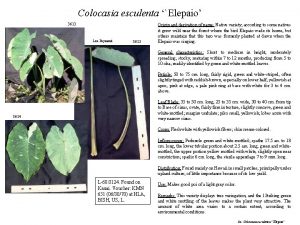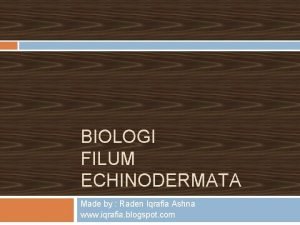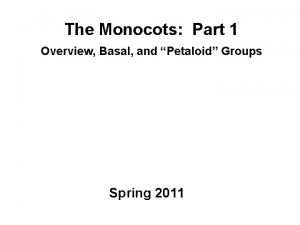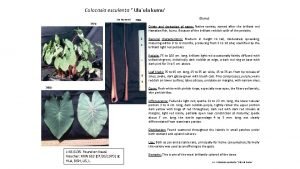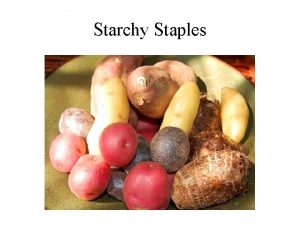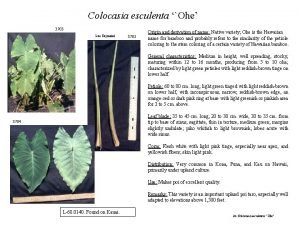Colocasia esculenta Ulaula moano 3685 Lisa Raymond 3687





- Slides: 5

Colocasia esculenta ‘`Ula`ula moano’ 3685 Lisa Raymond 3687 (Ieie, Iaia) Origin and derivation of name: Native variety; named after the Hawaiian fish moano, which is reddish to reddish-purple with brownish markings. General characteristics: Medium in height, moderately spreading, maturing 9 to I 8 months, producing from 5 to 10 oba; characterized by reddish-purple petioles with inconspicuous yellowish-green stripes. Petiole: 70 to 95 cm. long, red near base shading to reddishpurple above, with inconspicuous yellowish-green stripes especially an mid- section, indistinctly dark reddish at edge, a dark red ring at base with dark pink for 3 to 5 cm. above. 3686 Leaf blade: 35 to 45 cm. long, 25 to 35 cm. wide, 25 to 35 cm, from tip to base of sinus, ovate, dark glossy green with bluish cast; piko large, distinct, purple; primary and marginal veins reddish on lower surface; 16 bes obtuse with narrow sinus. Corm: Flesh white with pinkish tinge, especially near apex, the fibers yellowish; skin pinkish-lilac. Distribution: Planted in a few scattered localities throughout the islands, usually !-rider upland culture. L-68. 0136. Found on Kauai. Var. a. k. a. Ieie or iaia upland culture // Was planted MLMauka, Row 25 - Apr 68. // 2 huli to Waimea Arb. 5 May 82. Use: Both for poi and as table taro, principally for ham consumption. Ar - Colocasia esculenta ‘`Ula`ula moano’

Colocasia esculenta ‘`Ula`ula poni’ 3682 Lisa Raymond 3684 (Poni Ulaula) Origin and derivation of name: Native variety; poni, meaning “purple, " refers to the petiole coloring. General characteristics: Medium in height to tall, moderately spreading, maturing within 8 to 10 months, producing from 5 to 10 oha; recognized by the dark reddish-purple petioles, inconspicuously- striped with lighter color, with bright reddish edges. Petiole: 75 to 100 an. long, dark reddish-purple shading to purplish- lilac on upper third, inconspicuously striped with lighter color, distinctly bright reddish at edge, a purple ring at base with narrow, bright red area for 2 to 4 cm. above. Leaf blade: 35 to 45 an. long, 25 to 35 an. wide, 25 to 35 cm. from tip to base of sinus, ovate, dark glossy green with bluish cast; piko conspicuous, purple; veins bright reddish m lower surface; lobes obtuse, undulate an margins, with narrow sinus. 3683 Corm: Flesh white with pinkish apex, the fibers yellowish; skin brilliant lilac-pink, often dark purple along leaf-sear rings. Distribution: Often found associated with the other Ulaula, usually in the uplands. Use: Occasionally as a table taro; in early times a purple pigment was extracted from the petioles and used by the natives for dyeing tapa, straw hats, etc. L-69. 0046. Found on Kona, USA. Ar - Colocasia esculenta ‘`Ula`ula poni’

Colocasia esculenta ‘Manini kea’ 3694 Lisa Raymond 3696 Origin and derivation of name: Native variety; probably called Kea because of very light petioles. General characteristics: Medium in height to tall, well spreading, maturing in about 12 months, producing from 5 to 10 oha; distinguished by very light-colored petioles with indistinct reddishpurple stripes. Petiole: 65 to 90 cm. long, shading from light green to yellowishgreen toward apex with a few indistinct more or less interrupted reddish-purple stripes more prominent toward base, conspicuously reddish-purple at apex, an area of white for 3 to 5 am. above base, with inconspicuous faint pink to whitish edge. Leaf blade: 40 to 50 an. long, 30 to 35 cm. wide, 30 to 40 cm. from tip to base of sinus, sagittate, thin in texture, drooping, dark green, with bluish cast; piko purple; veins purple on lower surface of lobes; lobes acute with narrow sinus. 3695 Corm: Flesh white with yellow fibers; skin white to cream - colored. Distribution: Planted in a few scattered localities, under upland or wetland culture. Use: Makes poi of good quality. L-68. 0138. From Kauai. Voucher: KMN 565 (08/23/1969) at HLA, BISH, US, L. Remarks: This variety seems to be fairly resistant to soft rot. It is the lightest in color of the striped taros, both basically and as to stripes, which are, strictly speaking, flecking arranged in definite, narrow lines. Ar - Colocasia esculenta ‘Manini kea’

Colocasia esculenta ‘Manini uliuli’ 3691 Lisa Raymond 3693 Origin and derivation of name: Native variety; derives name from dark striping of petioles. General characteristics: Medium in height to tall, slender, erect, maturing in about 12 months, producing from 2 to 5 oha; characterized by broad purplish-black stripes an dark green petioles. Petiole: 75 to 90 cm. long, dark green with broad purplishblack stripes especially near base, with light pink to whitish edge, purplish-red at apex, white at base with livid brown for 3 to 4 an. above. Leaf blade: 35 to 50 cm. long, 25 to 35 cm. wide, 25 to 35 cm. from tip to base of sinus, sagittate, thin in texture, dark green; margins slightly undulate; piko purple; veins reddish on lower surface of lobes; lobes acute M narrow sinus. 3692 Corm: Flesh white with yellow fibers; skin yellowish with purple leaf scars. Distribution: Limited; grown equally well under upland or wetland culture. Use: Chiefly as table taro; makes poi of fair quality. L-66. 0118. From HAES. Voucher: KMN 569 (08/31/1969) at HLA, BISH, US, L. Remarks: The petiole stripes are less interrupted than in other striped varieties and very broad, especially at base, often coalescing to form purplish black blotches. Ar - Colocasia esculenta ‘Manini uliuli’

Colocasia esculenta ‘`O`opu kai’ 3688 (Kaimoi) Lisa Raymond 3690 Origin and derivation of name: Native variety; Oopukai means "sea guppy", a fish similar in coloring to the petiole of this taro. General characteristics: Medium in height, well spreading, maturing within 9 to 12 months, producing from 2 to 5 oha; distinguished by lilacpurple corm flesh and reddish-purple flecked stripes. Petiole: 65 to 90 cm. long, light yellowish-green with dark purple or reddish purple flecked stripes and blotches, dark red at edge, reddish purple at apex, a dark reddish-purple ring at base with purplish- pink for 3 to 4 cm. above. 3689 Leaf blade: 50 to 65 cm. long, 35 to 45 cm. wide, 40 to 50 cm. from tip to base of sinus, ovate, dark green with bluish cast; margins undulate; Piko purple, veins conspicuously reddish-purple over entire lower surface; lobes acute with wide sinus. Corm: Flesh light lilac-purple with darker purplish fibers; skin dark pinkish-lilac. Distribution: Planted fairly extensively in Kona, Hawaii, primarily under upland culture, but found only occasionally on the other islands. Use: Mainly as table taro; the leaves are often used for luau. Remarks: Although good poi can be made from this variety, it cannot be stored as long as poi from other taros due to over-rapid fermentation. Ar- Colocasia esculenta ‘`O`opu kai’
